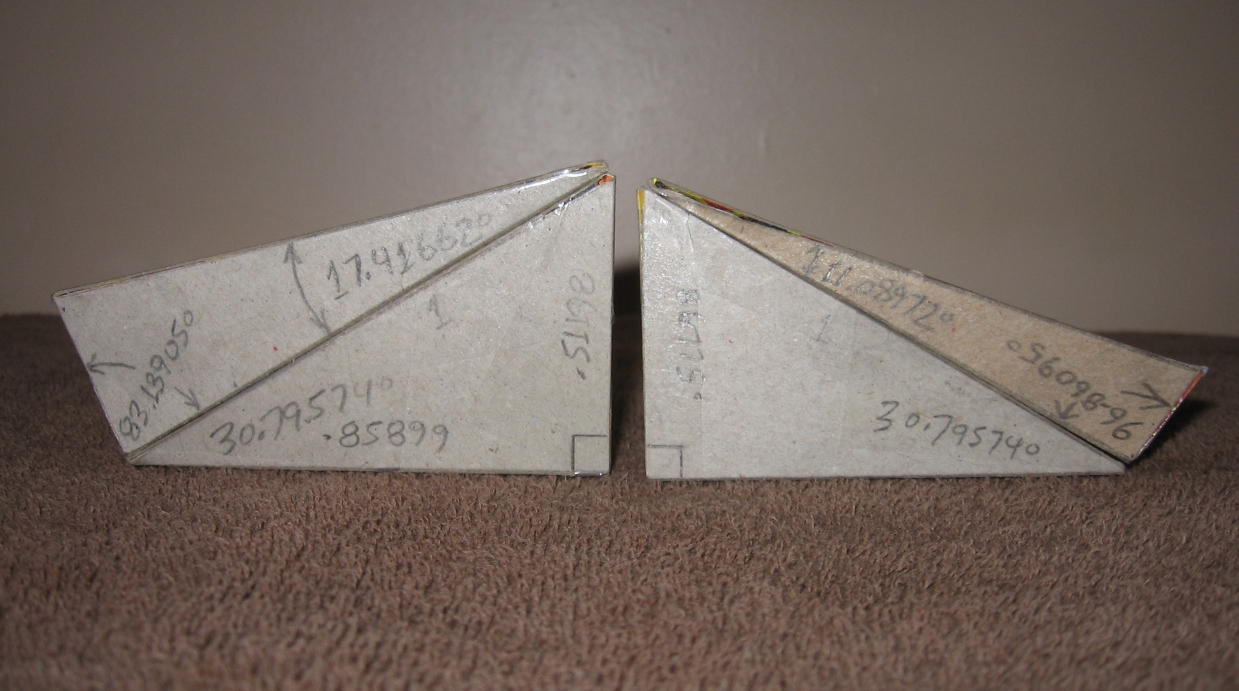Joe Bartok's study on the Golden Rhombus.
_________________________________________________________
And I stumbled across something else regarding the backing angles. I think
it's universal in scope – not only the Golden Rhombus but for any
tri-rectangular tetrahedron – no matter how we chose to cut the Hip rafters. I
have to make a couple of sketches first.
_________________________________________________________
Everything we've talked about in this series of emails reaches much farther than the Golden Rhombus Roof. It works for Archimedean Solids. It applies to tri-rectangular tetrahedra in general, and there are lots of those in a Hip-Valley roof. Where there’s a tri-rectangular tetrahedron there’s always a prismatic solid. And all the foregoing geometry ties into Non-Rectangular Sections.. my brain is going to have a meltdown ...
As I studied the dihedral angles in the Golden Rhombus I've wondered whether the backing angles are somehow entangled in a manner similar to a layover type roof. Or another example is square cut fascia, to cut along the P2 lines we use the backing angle from the opposing side of the roof.
The developed tetrahedra are exactly the same as the pentahedra except that the lines have been produced so the tiny triangles of the Hip Slope Angles disappear. When I resolved the dimensions – voila! – the backing bevels from both sides of the roof appeared. I back-tracked, did a bit more sketching, and found the formulas:
Adjoining Backing Angle = arctan (cos Sum of Angles on Roof Surface / tan Main Backing Angle)
Main Backing Angle = arctan (cos Sum of Angles on Roof Surface / tan Adjoining Backing Angle)
The backing angles and sum of the angles on the roof surface will be constants for a given roof condition so these formulas are true for any tri-rectangular tetrahedron or prismatic solid. Regardless of where we put the section plane in the tri-rectangular tetrahedron-prismatic solid those triangles of the backing angles will always appear in the two developed irregular tetrahedra.
Another result of the Golden Rhombus study – some
new tri-rectangular tetrahedron relationships. The angles doesn't have to be
strictly P2 and C5 as in the Golden Rhombus roof, angles in the same
location on the theoretical model can substitute. These are the seven
(there may be more) tri-rectangular tetrahedra in a standard Hip-Valley roof.
SS = Main Slope = 7/12
S = Adjoining Slope = 10/12
W = Eave Angle = 90°
The supplementary angle is used where the sums of angles exceeded 90°.S = Adjoining Slope = 10/12
W = Eave Angle = 90°
(1) 90° Corner Post Angles:
R4Pm = 32.27594°
R4Pa = 52.19482°
R4Pm + R4Pa = 84.47076°
A5Pm = 14.31575°
A5Pa = 20.68538°
A5Pm = arctan (cos 84.47076° / tan 20.68538°) = 14.31575°
A5Pa = arctan (cos 84.47076° / tan 14.31575°) = 20.68538°
(2) Valley intersects Principal Purlin, unbacked Upper
Shoulder
90° – R4Pm = 57.72406°
R3m = 30.06455°
90° – R4Pm + R3m = 87.78861°
A5Pm = 14.31575°
C2m = 8.59840°
A5Pm = arctan (cos 87.78861° / tan 8.59840°) = 14.31575°90° – R4Pm = 57.72406°
R3m = 30.06455°
90° – R4Pm + R3m = 87.78861°
A5Pm = 14.31575°
C2m = 8.59840°
C2m = arctan (cos 87.78861° / tan 14.31575°) = 8.59840°
(3) Prow Peak Angles (same as Rafter Square Cut)
90° – P2m = 58.84094°
90° – P5m = 39.02105°
180° – (90° – P2m + 90° – P5m) = 82.13801°
C5m = 16.79517°
P5BVm = 24.38004°
C5m = arctan (cos 82.13801° / 24.38004°) = 16.79517°90° – P2m = 58.84094°
90° – P5m = 39.02105°
180° – (90° – P2m + 90° – P5m) = 82.13801°
C5m = 16.79517°
P5BVm = 24.38004°
P5BVm = arctan (cos 82.13801° / 16.79517°) = 24.38004°
(4) Purlin Square Cut
90° – P4m = 61.73098°
P2m = 31.15906°
180° – (90° – P4m + P2m) = 87.10996°
P4BVm = 9.48356°
C5m = 16.79517°
90° – P4m = 61.73098°
P2m = 31.15906°
180° – (90° – P4m + P2m) = 87.10996°
P4BVm = 9.48356°
C5m = 16.79517°
P4BVm = arctan (cos 87.10996° / 16.79517°) = 9.48356°
C5m = arctan (cos 87.10996° / 9.48356°) = 16.79517°
C5m = arctan (cos 87.10996° / 9.48356°) = 16.79517°
(5) Jack Rafter and Purlin Angles
90° – R1 = 64.45755°
90° – R2m = 80.08972°
180° – (90° – R1 + 90° – R2) = 35.45273°
DD = 55.00798°
C1m = 29.69248°
90° – R1 = 64.45755°
90° – R2m = 80.08972°
180° – (90° – R1 + 90° – R2) = 35.45273°
DD = 55.00798°
C1m = 29.69248°
DD = arctan (cos 35.45273° / 29.69248°) = 55.00798°
C1m = arctan (cos 35.45273° / 55.00798°) = 29.69248°
C1m = arctan (cos 35.45273° / 55.00798°) = 29.69248°
(6) Valley Peak intersects Principal Purlin, housing angles
on Principal Purlin
90° – P3m = 75.51799°
Q2m = 85.05377°
180° – (90° – P3m + Q2m) = 19.42824°
90° – P2m = 58.84094°
C1m = 29.69248°
90° – P2m = arctan (cos 19.42824° / tan 29.69248°) = 58.84094°90° – P3m = 75.51799°
Q2m = 85.05377°
180° – (90° – P3m + Q2m) = 19.42824°
90° – P2m = 58.84094°
C1m = 29.69248°
C1m = arctan (cos 19.42824° / tan 58.84094°) = 29.69248°
(7) Valley Foot intersects Main Common Rafter, housing
angles on Common Rafter
90° – R5Pm = 68.61971°
90° – P6m = 81.12385°
180° – (90° – R5Pm + 90° – P6m) = 30.25644°
DD = 55.00798°
P2m = 31.15906°
DD = arctan (cos 30.25644° / tan 31.15906°) = 55.00798°90° – R5Pm = 68.61971°
90° – P6m = 81.12385°
180° – (90° – R5Pm + 90° – P6m) = 30.25644°
DD = 55.00798°
P2m = 31.15906°
P2m = arctan (cos 30.25644° / tan 55.00798°) = 31.15906°



















No comments:
Post a Comment
Note: Only a member of this blog may post a comment.